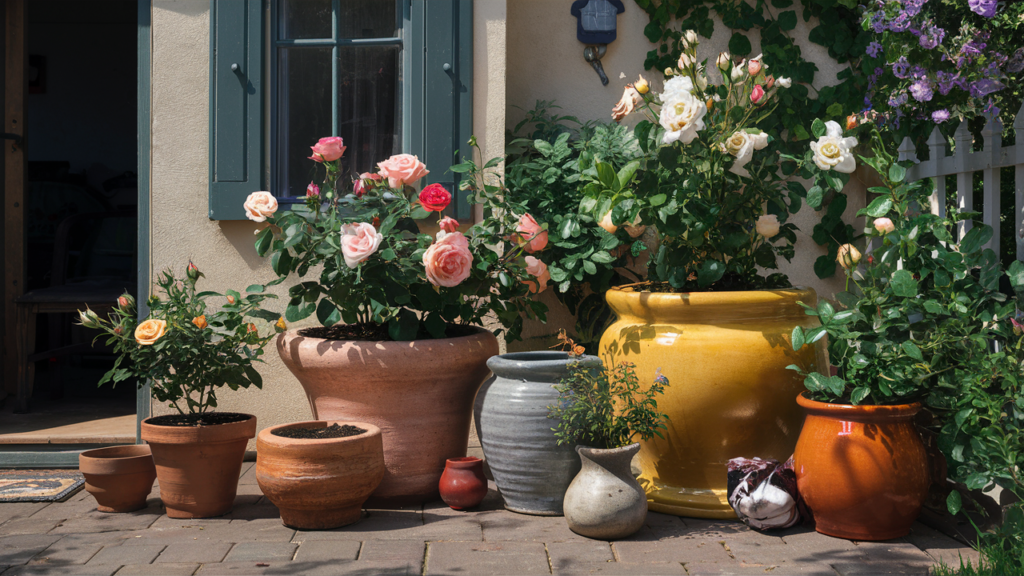
This website contains affiliate links, and some products are gifted by the brand to test. As an Amazon Associate, I earn from qualified purchases. Some of the content on this website was researched and created with the assistance of AI technology.
Key Takeaways:
- Choose the right size container based on the rose variety
- Select compact, disease-resistant rose types for containers
- Water potted roses when the top inch of soil is dry
- Use a high-quality, well-draining potting mix
- Opt for large, frost-proof pots with ample drainage
- Position pots for at least 6 hours of direct sun per day
- Practice regular pruning to shape containerized roses
- Mix rose varieties with contrasting colors and habits
What are the best tips for growing roses in patio pots?
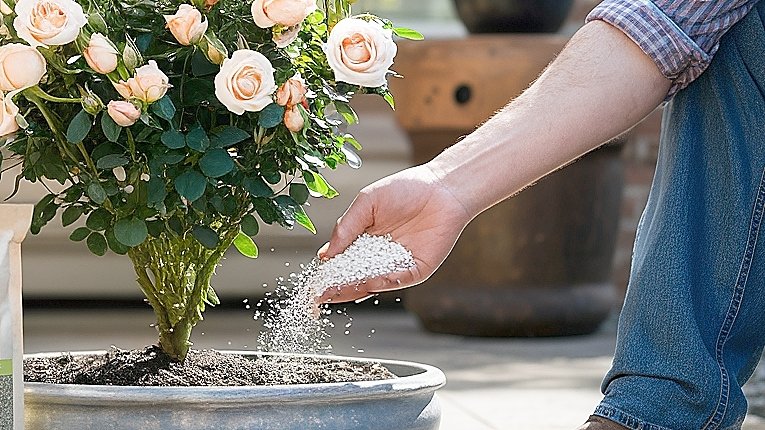
Coming from someone who’s spent decades mastering the art of growing lush, floriferous roses in containers and planters – this is one area where skimping on all the right know-how yields very mixed results. Just think compost heap disasters, stunted growth, yellowing leaves, disease issues…not quite the blooming rose patio paradise you had in mind, right?
On the flipside though, armed with pro-level skills around everything from cultivar selection and container choices to watering, feeding and pruning specifics? Well, that’s a total game changer when it comes to producing eye-popping containerized rose specimens absolutely dripping with romantic, fragrant floral displays all season long.
Trust me, it’s simpler than most think to cultivate jaw-dropping rose containers – even for pint-sized patio plots! As long as you’ve got full sun and the willingness to baby your beauties a tad more intensively than in-ground plantings, it’s honestly one of the most rewarding forms of raised-bed gardening out there. Lucky for you, I’m about to reveal all my top tips and trade secrets! And take a peek at my recent article about Low-Profile Rose Centerpiece Ideas for Small Spaces.
How to choose the right pot size for patio roses
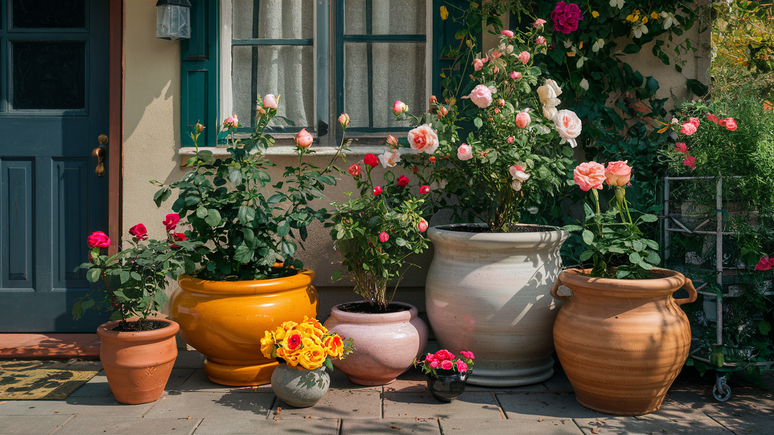
When it comes to growing fabulous roses in containers, there’s really no such thing as going too big in terms of pot size and volume capacity. While most shrub types can technically get by for a season or two in a 12-18″ planter, we’re talking tiny root prisons pretty much guaranteed to stunt plant vigor and blooming potential before you know it.
Nope, if you really want to facilitate those big, bountiful rose plant goals with minimal root binding, I always recommend springing for the largest, most spacious containers possible from the get-go. We’re talking at least 24″ diameter or the equivalent 5-7 gallon size reservoir at an absolute minimum. But upwards of 15-20 gallon tubs clocking in around 24-30″ wide? Even better for creating a permanent rose patio showpiece!
The added soil volume provides ample breathing room for developing robust root systems while making moisture management and nutrient access infinitely easier. Plus, let’s be real – larger containers are far more proportional to balancing those statuesque rose canes. It’s all about achieving an aesthetically pleasing, naturally-scaled look for your patio rose garden!
What are the best rose varieties for growing in patio pots?
- Drift Roses (low, spreading 1-2 ft shrubs, reblooming flowers)
- Oso Easy Landscape Roses (compact habit, low maintenance)
- Sunblaze Miniatures (prolific 12-24″ miniature rose cultivars)
- Flowercarpet Roses (dense, low-mounded shrubs for pots)
- Fairy Roses (micro-miniature just 6-8″ high, cute tiny blooms)
- Lady Banks’ Rose (rambling, trailing rose ideal for baskets)
- Polyantha ‘The Fairy’ (fountaining shrub, repeatedly flowering)
While old-fashioned hybrid teas and long cane climbers have their place in spacious raised beds, containers are really where versatile, modern and compact reblooming rose varieties truly shine. We’re talking small-statured yet flower-powered champs practically designed for the confined quarters of decorative planters!
Leading the pack are irrepressible ground-cover series like the iconic Drift Roses and black-tinged Oso Easy Landscape lineup – both bringing season-long color, disease resistance and a tidy, manageable scale around 2-3 feet tall. For even more petite sizes, you’ll fall head over heels for the ultra-miniature 12-24″ Sunblaze and Fairy rose crops exploding with continuous flushes of perfectly-formed hybrid blooms.
But for slightly taller containers better suited for patio accents and centerpieces, don’t sleep on old-world shrub rose selections like the perpetually-flowering, fountaining ‘The Fairy’ Polyantha or blithely trailing Ladies Banks’s rose. Both carry an elegance and nostalgic charm that just screams for decorative urns and raised brick planters!
How often should you water roses grown in patio pots?
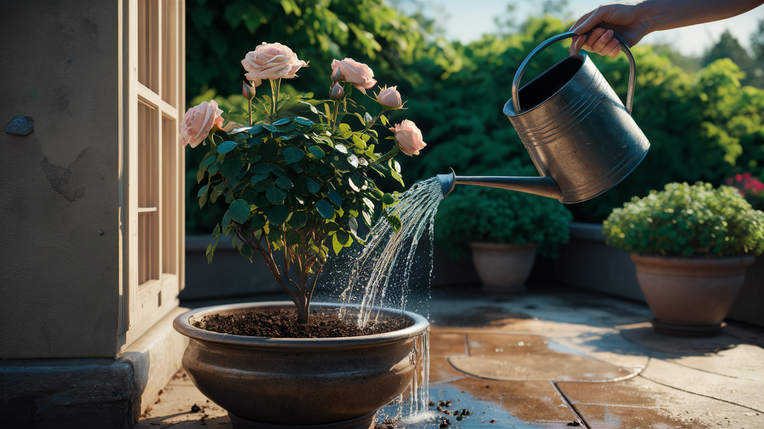
Given how rapidly containerized rose plants can deplete that limited moisture reservoir – especially as warm summer temps kick in – you can bet proper watering is absolutely critical for ensuring constant blooming power and preventing issues like blossom drop. This is one crop that simply won’t forgive forgetful or inconsistent hydration habits!
For most patio pots and medium to large-sized rose containers, plan on providing a deep, thorough soak at least twice per week with enough moisture to fully penetrate the entire root zone until it begins draining freely from the bottom. In intense heat or for exceptionally large bushes, however, you may need to up that schedule to daily watering during stretches of dry weather.
The key is to always check that the top inch of soil is getting a chance to dry out slightly between applications. And trust me, once you get the hang of monitoring moisture needs by both weight and the “stick your finger in the soil” method, it becomes second nature knowing exactly when your patio roses are starting to beg for a refill.
Just follow one critical pro rule – never let roses in containers remain saturated in soggy, wet soil for extended periods! That’s just asking for fatal issues like root rot and disease. With roses, it’s go big or go home with each watering!
What type of soil is best for growing roses in pots?
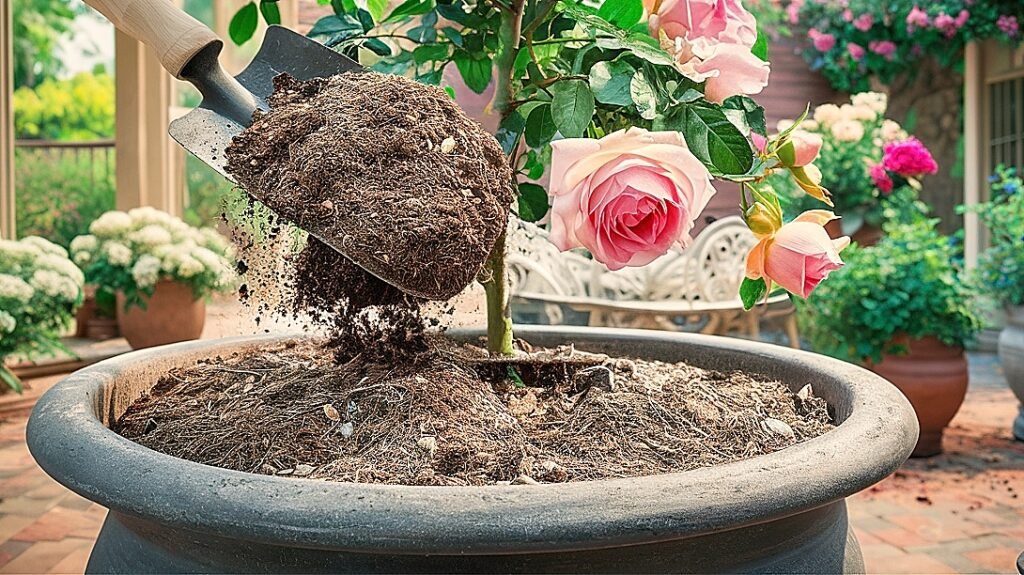
- Soilless Potting Mixes (lightweight, well-draining, sterile)
- Compost-Amended Garden Soil (nutrient-rich and fertilizing)
- Coir or Peat-Based Mixes (moisture-retentive, aids aeration)
- Bark/Pine Amendments (improves drainage, acid-loving types)
- Vermiculite/Perlite Additives (creates porous, free-draining mix)
For gardeners well-acquainted with growing roses in the ground, you know how these plants typically crave highly fertile, moisture-retentive yet free-draining loamy earth to put on their best floral show. But when it comes to cultivating roses in above-ground containers, that tried-and-true backyard garden staple is best left out of the soil equation entirely.
The simple reason? Dense, heavy clay and topsoil potting mixes tend to overly compact over time, creating anaerobic conditions and drainage nightmares even with the most perfectly-sized patio containers. Instead, nearly all rose growing pros rely on lightweight, porous and sterile commercial soilless blends specifically formulated for outstanding moisture management, air circulation and easy root establishment.
Leading the pack are premium all-purpose potting mixes comprised primarily of aged pine bark, compost, peat and sand/perlite. These provide the ideal combination of water-retention and porosity roses demand while doubling as fertile planters with a gentle, slow-release fertilizer charge. Others patio rose growers might opt to custom-blend their own soilless rose mediums by incorporating ingredients like coir fiber for added moisture-holding capabilities or chunky bark fines to enhance breathability for compost-hungry tea and English shrub varieties. While versatile orchid potting mixes infused with pine bark make for fabulous free-draining bases for miniature and micro-mini’s.
What are the best containers for growing roses on a patio?
- Terracotta Clay Pots (breathable, moisture-wicking ceramic)
- Glazed Ceramic Planters (durable, weather/frost-resistant)
- Wood Barrels/Planters (rustic, naturally insulating containers)
- Wrought Iron Containers (ornate, classic Victorian appeal)
- Plastic Resin Pots (affordable, lightweight movable options)
Just as critical as nailing that nutritious, well-draining potting medium is carefully selecting containers well-suited to meet the unique cultural needs of patio-grown rose specimens. You’re going to want ample volume capacity for establishing sprawling root systems, adequate drainage to flush out excess moisture and breathable walls to mitigate issues like heat buildup and moisture saturation.
For this reason, most rose gardeners tend to favor large-scale classic terracotta and ceramic planters for their porous, evaporative terra cotta clay construction that lets soil dry out efficiently between waterings. Glazed ceramic and porcelain urns provide a more refined aesthetic while ensuring frost-hardy durability. Naturally-insulating wood barrels and wine barrel halves also rank high for rustic cottage charm and providing gentle rot-resistance.
However, you can’t discount the sheer versatility of affordable, lightweight resin planters either. While not as breathable as their ceramic counterparts and not frost-proof, plastic’s mobility allows you to easily drag potted rose beauties into protected overwintering quarters. And who could resist the elaborate Victorian flair and heirloom sophistication of ornate wrought-iron cachepots for show-stopping patio centerpieces?
How to position potted roses on a patio for optimal sun exposure
With how paramount full, direct sunlight is for promoting prolific blooms, disease resistance and compact branching habits in patio rose plantings, you’d think locating the sunniest patio areas would be common sense, right? And yet, you’d be amazed at how often I encounter rose enthusiasts making the rookie mistake of tucking containers in too much shade!
So let this be your primary takeaway – for the vast majority of modern rose cultivars grown in containers, you’ll want to secure a spot featuring a bare minimum 6-8 hours of direct, unobstructed sunlight daily. We’re talking prime southern/western exposures receiving sunbeams from midday forward through late afternoon.
Of course, morning sun exposure is ideal too for drying off dew and foliar moisture. Some heat-loving rose shrubs like Meidilanders and Drifts even tolerate 8-10+ hours of sun per day in hot climates. But for old English and tea rose types prone to scorching and bleaching, I’d suggest slightly more afternoon shaded areas if possible.
Hot pro tip? In confined outdoor rooms without wiggle room, simply elevate containers on raised platforms or plinths 1-3 ft off the ground. With rose bushes gaining a literal 360-degree solar boost, you’ll reap fuller flowering and significantly accelerate growth rates!
How to prune roses in containers to encourage healthy growth
Seasoned rose growers understand how critical judicious pruning is to maintaining outward plant size, invigorating productive blooms, increasing air flow and shaping the overall form and habit of rose bushes. And when confined to container culture? Let’s just say those pruning chores become even more crucial to avoid leggy, sparse, and overgrown messes.
My personal rule of thumb for patio pots involves an early spring annual pruning down to around 12-18″ above the graft union once winter protection is removed. This resets container rose specimens with a flush of vibrant, compact new basal growth replacing any dead, discolored or mis-shapened wood. Proper thinning, debudding and deadheading also helps…
As the growing season progresses, you’ll want to continuously remove faded, spent blooms to promote repeat flowering cycles. Don’t be afraid to periodically prune back rangy, unruly branches and weak lateral growth to expose the plant’s interior either. When fall arrives, roses should receive yet another cleanup pruning prior to winter dormancy – removing up to 1/3 of the overall rose canopy mass.
How to mix rose varieties in one container for an eye-catching display
For rose fanatics who live for experimenting with unusual, visually-striking combinations – few gardening endeavors produce as much sensory overload and creative freedom as container rose arrangements! Just picture multi-hued specimen floribundas and miniatures artfully unified within a single statement ceramic planter, framed by a whimsical billowing drift ground cover trailing over the sides. It’s fresh, eye-catching and impressively ornamental in a way that always stops passerby traffic.
Even simpler treasures like unified single variety plantings still allow for captivating diversity through clever use of contrasting flower colors, bloom sizes and varied plant habits/textures. Think a radiant magenta climber cloaking one side of a large urn while a snowy-white Lady Banks rambler cascades from the opposite profile. The layered, multi-level dimensionality and visual rhythm it creates is magical.
Of course, for real “wow” factor, you’ve also got to consider foliage contrasts – maybe offsetting sleek, leathery-leafed shrubs with ruffled textures and ferny accents. For killer height and drama, I’m a huge fan of shooting up a statuesque self-supporting tree rose through the middle surrounded by a carpet of petite fairy-sized micro minis. You can even work in fragrance dimensions for an olfactory experience! The botanical artistry is truly limitless when working with such portable “living containers”.
Conclusion
Ok rose fiends, let’s quickly recap all those major takeaways for cultivating Instagram-worthy container rose plantings that’ll leave your patio smothered in lush floral opulence all season! First and foremost, be meticulous about choosing the ideal modern, disease-resistant and compact reblooming varieties bred explicitly for confined root zones.
Next up? Give those roses ample leg room by using extra-large pots and premium soilless growing mediums that balance water retention with excellent drainage. Be diligent about positioning those planters in optimal all-day sun exposures, while keeping a consistent watering regimen targeted to each rose’s maturing root system.
Oh and don’t discount the artistry involved too – from pruning to maintain outward size, shape and prolific blooms to pushing creative boundaries by mixing varieties, bloom forms, textures and fragrance levels into a single curated rose medley! With a bit of trial and error, your patio will become a true rose destination garden.
So what are you waiting for? Start hunting down those irresistible new introductions and timeless classics today. Then take advantage of that bonus small-scale mobility to endlessly reshuffle your arrangements all season for endlessly fresh looks! Just wait until your neighbors get a whiff of your budding patio rose paradise.
This website contains affiliate links, and some products are gifted by the brand to test. As an Amazon Associate, I earn from qualified purchases. Some of the content on this website was researched and created with the assistance of AI technology.
